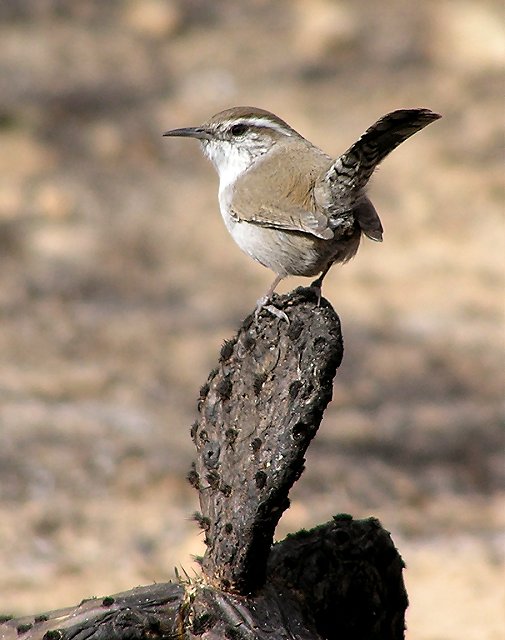BigRedBirder (talk | contribs) |
|||
| Line 1: | Line 1: | ||
| − | ;Thryomanes bewickii | + | ;[[:Category:Thryomanes|Thryomanes]] bewickii |
[[Image:Bewicks_Wren.jpg|thumb|550px|right|Photo by Leslie]] | [[Image:Bewicks_Wren.jpg|thumb|550px|right|Photo by Leslie]] | ||
| Line 17: | Line 17: | ||
==Distribution== | ==Distribution== | ||
| − | Throughout the SW quadrant and Pacific Coastal regions of the U.S., extending deeply into central Mexico. Much less common east of the Mississippi, with dramatically declining populations extending to the Appalachian mountains. | + | Throughout the SW quadrant and Pacific Coastal regions of the [[U.S.]], extending deeply into central [[Mexico]]. Much less common east of the Mississippi, with dramatically declining populations extending to the Appalachian mountains. |
==Habitat== | ==Habitat== | ||
Open country; mixed scrub, grass, and wooded areas. | Open country; mixed scrub, grass, and wooded areas. | ||
| Line 32: | Line 32: | ||
==External Links== | ==External Links== | ||
{{GSearch|Thryomanes+bewickii}} | {{GSearch|Thryomanes+bewickii}} | ||
| − | [[Category:Birds]] | + | [[Category:Birds]] [[Category:Thryomanes]] [[Category:Incomplete]] |
Revision as of 14:49, 19 October 2008
- Thryomanes bewickii
Identification
L. 13.3cm (5.25in)
Ws. 18.4cm (7.25in)
- Overall drab color
- Grays in the West; browns in the East
- Unmarked, lighter underside
- White to gray
- Long barred tail
- Decurved bill
- White eyebrow
Similar Species
Similar to Carolina Wren
Distribution
Throughout the SW quadrant and Pacific Coastal regions of the U.S., extending deeply into central Mexico. Much less common east of the Mississippi, with dramatically declining populations extending to the Appalachian mountains.
Habitat
Open country; mixed scrub, grass, and wooded areas.
Taxonomy
On the order of 15 geographically separate subspecies have been documented; two went extinct in the early 1900s from predation and habitat destruction.
Behaviour
A relatively tame and conspicuous bird, it allows close approach, and is comfortable in man-made environments, often nesting in cavities provided by structures.
Diet
Insectivorous
Breeding
Monogamous




